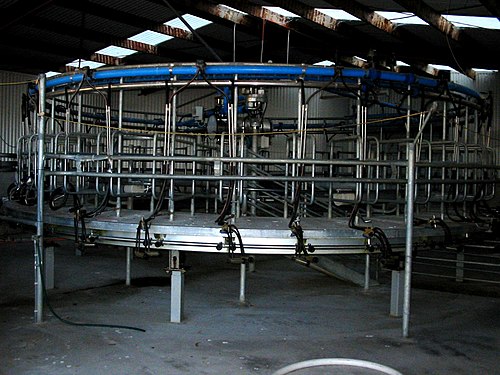This articleneeds additional citations forverification. Please helpimprove this article byadding citations to reliable sources. Unsourced material may be challenged and removed. Find sources: "Sheep milk" – news ·newspapers ·books ·scholar ·JSTOR(October 2014) (Learn how and when to remove this message) |

Sheep milk is themilk ofdomestic sheep. It is commonly used to make cultureddairy products, such as cheese. Some of the most popular sheep cheeses includefeta (Greece),pecorino romano (Italy),Roquefort (France) andManchego (Spain).
Specialized dairy breeds of sheep yield more milk than other breeds. Common dairy breeds include:
In the U.S., the most common dairy breeds are the East Friesian and the Lacaune.[1] Meat or wool breeds do not produce as much milk as dairy breeds, but may produce enough for small amounts of cheese and other products.

Female sheep (ewes) do not produce milk constantly. Instead, they produce milk during the 80–100 days after lambing.[2] Sheep naturally breed in the fall, which means that a majority of lambs are born in the winter or early spring. Milk production decreases and eventually stops when lambs are weaned or the days are shorter.[1] Milk cannot be produced year-round.[3] Through the use ofcontrolled internal drug release (CIDR), ewes can be bred out of season. CIDR drugs containprogesterone, which is slowly released into the bloodstream, bringing the animal intoestrus.[4] In this way, ewes can be bred at different times throughout the year, providing farms with a year-round supply of milk.
Meat and wool breeds of sheep lactate for 90–150 days, while dairy breeds can lactate for 120–240 days. Dairy sheep can produce higher yields of milk per ewe per year. Dairy sheep can produce 400–1,100 lb (180–500 kg) of milk per year while other sheep produce 100–200 lb (45–91 kg) of milk per year. Crossbred ewes produce 300–650 lb (140–290 kg) of milk per year.[1]
Sheep milk cheeses include thefeta ofGreece,Roquefort of France,Manchego of Spain;Serra da Estrela fromPortugal;pecorino Romano (theItalian word for sheep ispecora) andpecorino Sardo ofItaly;Pag cheese of Croatia;Ġbejna of Malta; andGomolya of Hungary; andBryndza (Slovenská bryndza fromSlovakia,brânza de burduf fromRomania andBryndza Podhalańska fromPoland).
Whey cheeses are also made from sheep's milk: variousricottas of Italy (but the best-known are made from buffalo milk);anthotyros,mizithra,manouri, andxynomizithra of Greece (often with goat milk mixed in); variousrequeijão in Portugal.
In Greece,yogurt is often made from sheep's milk.

| Constituents | Unit | Cow | Goat | Water buffalo | Sheep |
|---|---|---|---|---|---|
| Water | g | 87.8 | 88.9 | 81.1 | 83.0 |
| Protein | g | 3.2 | 3.1 | 4.5 | 5.4 |
| Fat | g | 3.9 | 3.5 | 8.0 | 7.0 |
| —Saturated | g | 2.4 | 2.3 | 4.2 | 3.8 |
| —Mono-unsaturated | g | 1.1 | 0.8 | 1.7 | 1.5 |
| —Polyunsaturated | g | 0.1 | 0.1 | 0.2 | 0.3 |
| Carbohydrate (lactose) | g | 4.8 | 4.4 | 4.9 | 5.1 |
| Energy | kcal | 66 | 60 | 110 | 95 |
| kJ | 275 | 253 | 463 | 396 | |
| Cholesterol | mg | 14 | 10 | 8 | 11 |
| Calcium | IU | 120 | 100 | 195 | 170 |
Sheep's milk is exceptionally high in fat and conjugated linoleic acid (CLA) and has a high level of solids,[6] as compared to other kinds of milk, making it very suitable for cheese-making. In particular, sheep's milk produces much more cheese than the same amount of cow's milk.[7]